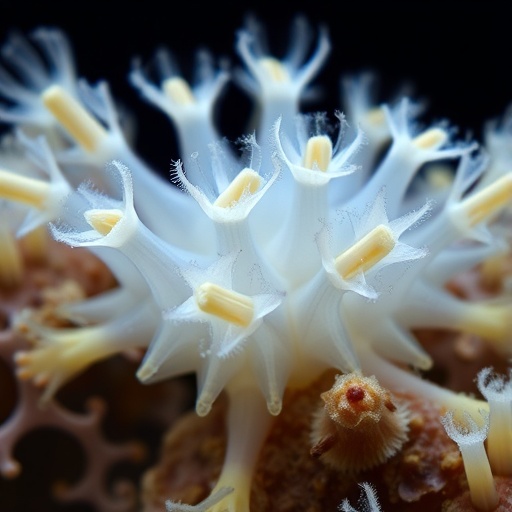In recent years, marine ecology has increasingly focused on the intricate relationships that exist within various ecosystems, particularly in harsh environmental conditions. One major study authored by Maeda et al. delves into the fascinating world of dinoflagellates and their association with large benthic foraminifera found in challenging shallow-water habitats. This inquiry sheds light on the diverse interactions that occur in marine environments often overlooked in ecological research. The study highlights the unique characteristics of dinoflagellate communities, which serve as crucial indicators of environmental change and the health of marine ecosystems.
The research explores how the diversity of dinoflagellates, a group of predominantly marine planktonic protists, influences and is influenced by their symbiotic relationships with large benthic foraminifera. These foraminifera, single-celled protists characterized by their complex shell forms, serve as a pivotal component of marine ecosystems. They not only provide habitat and sustenance to dinoflagellates but also have a significant influence on nutrient cycling and energy transfer within their environments. The investigation underscores the importance of these relationships as they contribute to the overall resilience and functioning of marine ecosystems.
Maeda and colleagues employed a variety of sampling techniques and analytical methods to assess dinoflagellate diversity in several harsh shallow-water environments. By utilizing both in situ observations and laboratory experiments, the authors were able to garner comprehensive data on the distribution, abundance, and community structure of these organisms. Their systematic approach capitalized on the latest molecular techniques which afford detailed insights into species identification and population dynamics, allowing for a more nuanced understanding of the biodiversity present in these habitats.
One of the striking findings of the study is the exceptional adaptability of certain dinoflagellate species. In environments characterized by extreme conditions such as low light, high salinity, and fluctuating temperatures, some dinoflagellates have developed unique physiological traits that enable them to thrive. This adaptability not only enhances their survival but also enriches the genetic diversity of the community, thus fortifying the resilience of the ecosystem. Such adaptations offer a glimpse into the evolutionary processes at play within these extreme habitats, suggesting that the potential for resilience among marine organisms is greater than previously understood.
Additionally, the paper draws attention to the interspecific relationships between dinoflagellates and benthic foraminifera. The study found that these relationships are dynamic and can vary dramatically based on environmental conditions. For instance, under certain stress conditions, specific dinoflagellate species were found to either proliferate or diminish, which consequently affected the foraminifera that relied on them for nutrition. These observations indicate that understanding the nuances of these relationships is crucial for predicting how marine ecosystems might respond to changing environmental parameters, such as climate change and pollution.
The authors also enhance their findings with a discussion on the implications of dinoflagellate diversity for broader ecological research. The presence of diverse dinoflagellate communities could signify a robust and resilient ecosystem capable of withstanding perturbations. Conversely, areas with reduced dinoflagellate diversity may serve as indicators of ecological decline and vulnerability. By linking benthic foraminifera health to dinoflagellate diversity, the authors argue for the incorporation of these organisms into ecological monitoring programs designed to assess marine health.
Throughout the research, the interplay between biological diversity and environmental stressors becomes evident. The interactions between dinoflagellates and their larger, benthic counterparts highlight the intricacies of food webs within marine systems. Given their ecological roles, it is vital to understand how changes in temperature, salinity, and nutrient input may influence these relationships. This understanding is especially relevant as ocean acidification and global warming continue to disrupt marine environments around the world.
In addition to its fundamental contributions, this research has tangible implications for conservation strategies. By elucidating how dinoflagellate diversity relates to the health of benthic foraminifera populations, the study provides essential information that could help inform targeted conservation efforts. A focus on preserving diverse dinoflagellate communities could facilitate the maintenance of ecological balance in shallow-water environments, which are often under severe threat from human activity and climate change.
Moreover, the study addresses how local disturbances could have cascading effects on larger ecological frameworks. By disrupting the delicate symbiosis between dinoflagellates and foraminifera, inputting pollutants into the marine ecosystem could lead to lasting impacts on biodiversity and ecosystem health. The paper strongly advocates for increased awareness and efforts to mitigate these impacts in order to preserve vital marine habitats and the biodiversity they support.
Finally, the implications of this research extend beyond the particular ecologies explored in the study. The foundational concepts presented regarding the interactions of dinoflagellates and foraminifera have parallels in other ecosystems worldwide. Similar dynamics may be observed across various marine settings, making this research relevant for a broader audience interested in understanding marine biodiversity and resilience.
As the exploration of marine biodiversity advances, studies such as this play an essential role in shaping our understanding of ecological dynamics, pushing forward our appreciation for the complex interdependencies that characterize marine life. This ongoing dialogue encourages further inquiry and remediation efforts that support the sustainment of healthy marine ecosystems.
In conclusion, the investigation conducted by Maeda et al. offers rich insights into the world of dinoflagellate diversity within large benthic foraminifera communities thriving in harsh shallow-water environments. The relationships forged between these two crucial groups illustrate the complexity of marine ecosystems and underscore the importance of protecting them in an era of rapid environmental change. Continuous research in this domain will equip scientists and policymakers alike with the knowledge necessary to combat ecological decline and reinforce the resilience of our planet’s oceans.
Subject of Research: Dinoflagellate diversity and its association with large benthic foraminifera in harsh shallow-water environments.
Article Title: Dinoflagellate diversity of large benthic foraminifera in harsh shallow-water environments.
Article References:
Maeda, A., Hamamoto, K., Nishijima, M. et al. Dinoflagellate diversity of large benthic foraminifera in harsh shallow-water environments.
Coral Reefs 44, 1197–1209 (2025). https://doi.org/10.1007/s00338-025-02671-4
Image Credits: AI Generated
DOI: https://doi.org/10.1007/s00338-025-02671-4
Keywords: Dinoflagellates, Benthic Foraminifera, Marine Ecology, Biodiversity, Environmental Stress, Ecosystem Resilience, Conservation, Climate Change.




